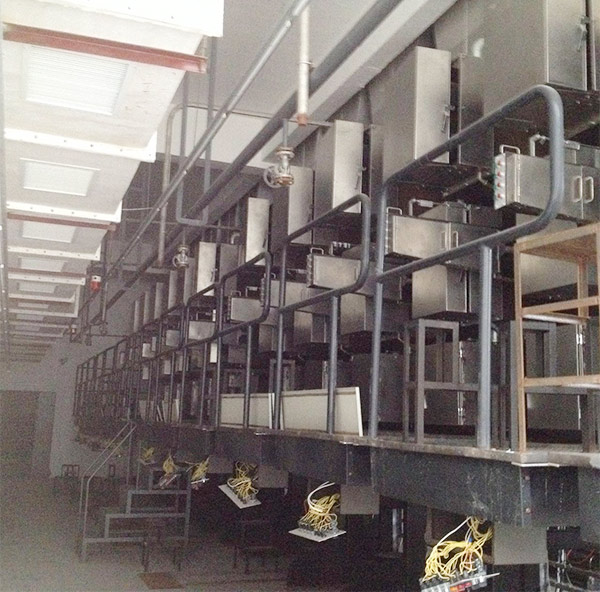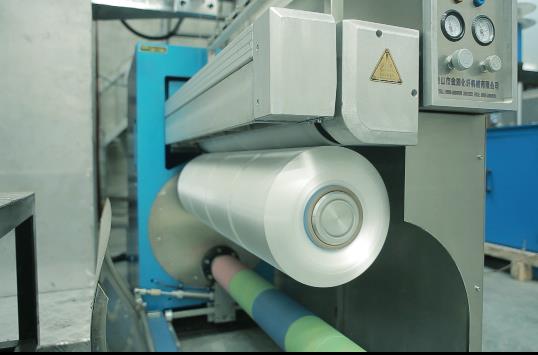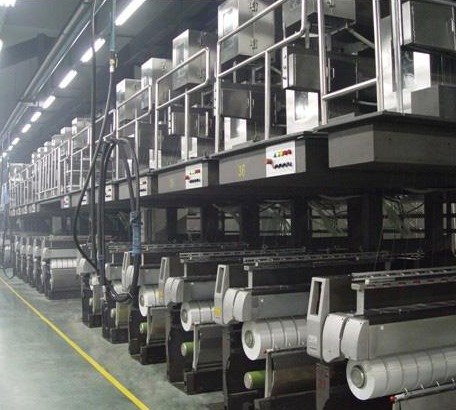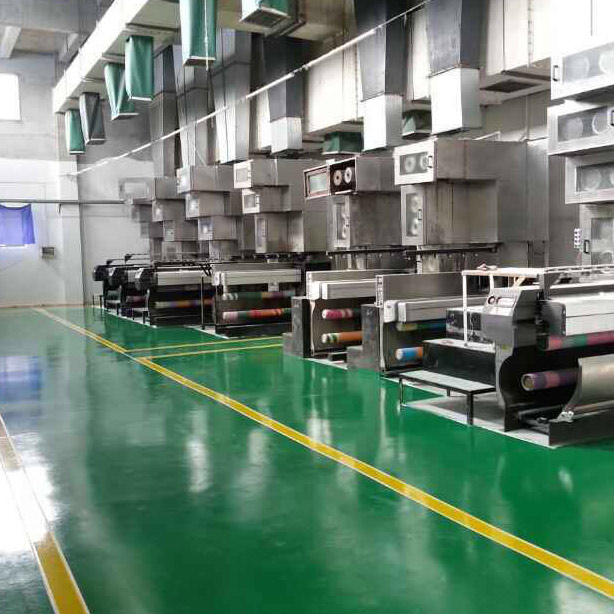- Polypropylene spinning machine
- Polypropylene FDY equipment
- Polyester POY spinning machine
- Polyamide FDY common and high strength equipment
- Polyester FDY equipment
- Polyester high strength equipment
- polyester、Polyamide、 Polypropylene BCF equipment
- Small spinning machine
- All kinds of spinning special parts
- Polypropylene FDY spinning machine is a key equipment for the production of high-performance fibers
- Several silk textile industry renewal projects in Shengze have started construction
- The Winter Solstice marks the rise of Yang energy. In Fubon spinning machines, the Winter Solstice code is revealed, a dialogue of craftsmanship spanning a thousand years
- The establishment conference of Guangzhou Modern Textile and Garment New Quality Productivity Research Institute and the co-construction conference of the textile industry innovation ecosystem were held
- The key points of control in the polypropylene FDY spinning machine process and their relationship with quality

- Contact:Mr. Huang Guofu
- Cel:0086-13901505556
- Fax:0086-519-83341119
- Email:czfb5556@126.com
- Add:No. 288-8 ChangLi Rd, Huangli Town, Changzhou, JS PRV.
Analysis of the Status Quo of Foreign Trade Enterprises
In recent days, as the epidemic situation across the country gradually returns to normal, everything is thriving. What is the current situation of those foreign trade enterprises that have been "robbed for orders", and has their severe situation eased?
Southeast Asia orders have been placed until the end of the third quarter
Recently, Vietnamese media reported that the export orders of many enterprises have increased, and the order volume is gradually filling up. Analysts predict that Vietnam's textile and clothing exports this year are likely to exceed the established target of 42 billion to 43 billion US dollars.
In the first five months, Vietnam's textile and apparel exports totaled US$18.7 billion, an increase of 23.5% over the same period in 2021. The export orders of enterprises have been placed at the end of the third quarter. Among them, Vietnamese textiles and garments have achieved considerable results in major markets such as the United States, Europe, and Japan.
The order situation of export enterprises is quite stable. But Nguyen Thi Xue Mai, deputy secretary-general of the Vietnam Textile and Apparel Association, said that the current difficulty faced by companies is that they cannot recruit more workers to fulfill the new orders.
In addition, Vietnam has vigorously built its manufacturing industry by reducing tariffs and attracting investment through policies. In addition, the United States has used methods such as raising import tariffs on Chinese goods and setting up Sino-US trade barriers to obstruct China's export trade. In order to avoid being levied high tariffs, Chinese export companies have taken measures to bypass Vietnam. As a member of Southeast Asian countries, Cambodia has also handed in a good transcript. According to statistics from the General Administration of Customs of the country, in the first five months, Cambodia's total exports reached US$9.412 billion, a year-on-year increase of 34.5%; among which, exports of clothing, shoes and travel goods reached US$5.2 billion, accounting for 55% of total exports.
China's manufacturing industry is in trouble
In contrast, although China's textile and apparel exports have achieved year-on-year growth in the first five months, Chinese textile and apparel exporters are still faced with business problems such as order transfer and difficulty in ensuring the stability of the supply of textile and apparel raw materials. In the future, China's textile and apparel exports will continue to grow. The pressure is high.
Some experts said: "At present, the global textile industry is in the stage of transferring to Southeast Asia. Due to the obstruction of the industrial chain of domestic textile enterprises, the efficiency of textile and clothing supply has declined, and with the gradual maturity of high-end clothing industry technology in Vietnam, India and other countries, industrial transfer has appeared. Signs of acceleration, China's textile and apparel export competition is becoming increasingly fierce."
The outflow of orders is on the one hand, and on the other hand, the cost of China's manufacturing industry is shackled by external forces and continues to rise.
Analysts said that the current international situation is changing rapidly, and trade protectionism has occurred frequently in various countries around the world. Some countries have raised commodity export tax rates and even implemented commodity export bans, which has exacerbated the global shortage of textile raw materials. This approach not only raised the cost of imported cotton in China, but also affected the supply stability of the textile industry chain. China's textile and apparel export enterprises encountered difficulties in their operations. Some cotton spinning companies have reported that due to export requirements, some textile and apparel export orders have to be converted to imported cotton production, resulting in a sharp increase in the number of pure US cotton orders from May to June, but the price of US cotton to the factory is about 24,000 yuan / ton. High costs have greatly reduced the profit margins of spinning companies using imported cotton.
Market performance, startup down, orders down, inventory up
Recently, the China Cotton Textile Industry Association conducted a survey on the operation of the industrial cluster market. Affected by factors such as the current off-season market and the US "Xinjiang-related Act", the opening rate of cluster enterprises has declined, orders have declined, inventories have risen, and operating pressure has continued to increase.
According to the reflection of white grey cloth cluster enterprises, the current opening rate is about 80%. Affected by various factors such as insufficient market demand, poor price transmission, and power cuts in some coastal cities, the printing and dyeing bases in Zhejiang and Guangdong were under-operated, and the number of grey fabric orders fell significantly year-on-year. It is expected that the production and operation pressure of enterprises may further increase.
According to the reflection of the yarn-dyed fabric cluster enterprises, the operation of the enterprises is basically normal, but the situation of insufficient capacity utilization is more common. Product orders of most companies have declined to a large extent, and a small number of companies have temporarily stopped production. Combined with exchange rate fluctuations and other factors, export orders have been greatly affected. It is expected that the market situation will be difficult to improve in the short term.
According to the reflection of the denim cluster enterprises, the current operation is basically normal, and the opening rate has been reduced. The order situation is not optimistic, the product price is depressed, there is basically no profit margin, and the inventory continues to increase. It is expected that during the off-season, the company may further reduce the operating rate.
From the demand side, the current domestic performance is still weak, the gauze inventory is high, the terminal demand and export volume are relatively poor, and the current market overall consumption desire is poor, and it is difficult to see a significant improvement in consumption in the short term. However, with the sharp drop in the price of raw materials, the profits of enterprises have improved. If this situation can continue, it will be good for textile enterprises, and future consumption can also be expected. However, there are large pessimistic expectations in the current export market. After the pessimistic expectations in the future become reality, it will have a very large impact on the consumption of textiles. This is a consumer-side risk that cannot be determined at present.
Disclaimer: This article is organized from the Internet, and the copyright belongs to the original author; if there is any infringement, please inform in time, and delete it after verification.
- Several silk textile industry renewal projects in Shengze have started construction
- Polypropylene FDY spinning machine is a key equipment for the production of high-performan
- The Winter Solstice marks the rise of Yang energy. In Fubon spinning machines, the Winter
- The establishment conference of Guangzhou Modern Textile and Garment New Quality Productiv
- The key points of control in the polypropylene FDY spinning machine process and their rela
- A Guide for Managers to Break Through: Empowerment Rather than Control: Helping Enterprise
- The 2025 Textile and Garment Innovation Annual Conference and the Gongqingcheng Down Indus
- The technological upgrade of polypropylene FDY spinning machines empowers the production o
- Textile News: Full-chain Efforts + Cross-border Breakthroughs + Talent Foundation - The Te
- The 2025 China Home Textile Fashion Innovation Conference grandly kicked off in Binzhou




